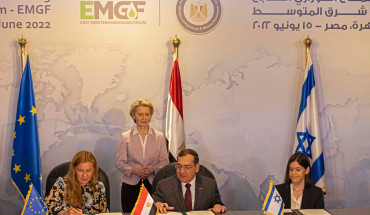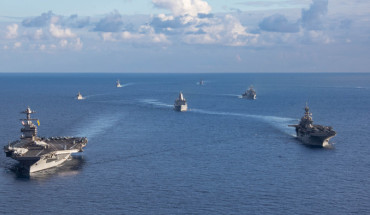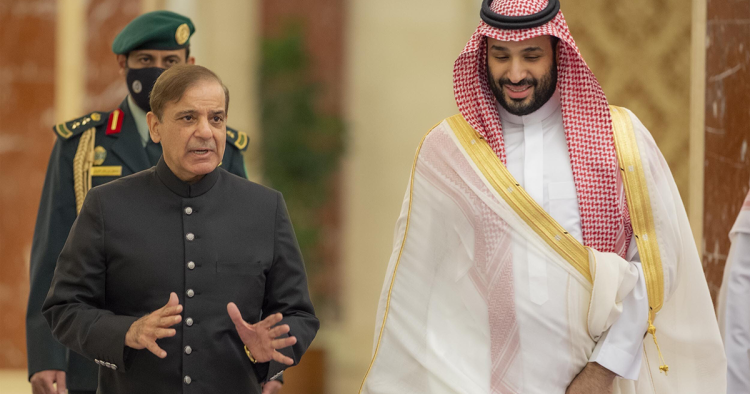It was no surprise to see the newly elected Pakistani prime minister, Shehbaz Sharif, choose Saudi Arabia as the destination of his first official visit within weeks of assuming power. What was more surprising, however, was the joint announcement that emerged from this two-day visit in early April, which not only reiterated a Saudi pledge to invest $5 billion in Pakistan, but also called on Pakistan and India to resolve their outstanding disputes, especially the Jammu and Kashmir problem.
The Saudis are not alone in their desire to see India and Pakistan address the root causes of lingering tensions between the two largest South Asian states. The United Arab Emirates also played an instrumental role in brokering a cease-fire between Islamabad and New Delhi in 2021, which halted dangerous cross-border skirmishes that had reignited in 2019.
There are several factors that have impelled the two most powerful Gulf states to take on the tricky task of mediating a protracted rivalry rather than just remaining neutral and continuing to maintain strong bilateral ties with both India and Pakistan. To understand why, and how, the Saudis and Emiratis are trying to assume the role of mediators in the long-running conflict on the Indian subcontinent necessitates an appreciation of modern historic and geostrategic developments within both the Middle East and South Asia.
Post-colonial interactions between Pakistan, India, and the Middle East
Ties between the Middle East and South Asia can be traced back centuries through a long history of commercial, religious, and cultural interactions. However, much has happened in more recent times as well, especially since the emergence of modern Middle Eastern states following the collapse of the Ottoman Empire and the creation of India and Pakistan through partition.
Saudi Arabia became a major patron for Pakistan, a resource-constrained but sizeable Sunni-majority Muslim country, soon after its creation in 1947. Over the years, the Saudis have repeatedly come to Pakistan’s aid, alongside the UAE, providing it with loans, grants, and concessional oil. The two Gulf states are the preferred destination for Pakistan’s 12.4 million overseas workers, including more than 77% of the nearly 830,000 who travelled abroad to work in 2022; these workers, in turn, send home sizeable remittances that help to keep the domestic economy afloat.
Beyond economic ties, there is also a strategic and security dimension to Pakistan’s relations with Saudi Arabia and the UAE. Pakistan not only worked closely with Saudi Arabia and the US to train “holy warriors” to fuel a jihad against the Soviet Union following its occupation of Afghanistan in 1979, but it also stationed tens of thousands of troops in the kingdom during the Iran-Iraq war in the 1980s. Pakistan has long provided military training and exported arms to Saudi Arabia and the UAE as well. Amid the chaos that befell Afghanistan following the Soviet exit in 1989, Pakistan, alongside Saudi Arabia and the UAE, backed the rise of the Taliban in the early 1990s, and these three countries were the only ones in the Muslim world to recognize the Taliban regime that assumed power in 1996. While Pakistan saw the primarily Pashtun and ultraconservative Taliban regime as a necessary buffer against India, India and Iran began to support the multi-ethnic Northern Alliance, which sought to resist the Taliban.
Despite its long-standing ties with Saudi Arabia and the UAE, Pakistan has a sizeable Shi’a minority too, and it aspires to maintain ties with Iran as well. Iran, in fact, was the first country to recognize Pakistan’s independence from the British. Under the reign of the shah, Iran and Pakistan forged a closer security relationship due to their involvement in the US-led regional Cold War alliance better known as the Baghdad Pact. However, the 1979 Iranian revolution upended such geostrategic linkages. Pakistan then had to navigate its relationship with a divided Middle East riven by an intense rivalry between Iran and Saudi Arabia. Pakistan became an arena for the sectarian proxy war between the two regional powers, exacerbated by the rise of intolerant Sunni militant outfits nourished with Saudi and American support for use in the Afghan jihad against the Soviets. As a result, sectarianism has taken on a life of its own within Pakistan.
More recent developments influencing relations between Middle East, India, and Pakistan
Pakistan has tried to bolster ties with Iran in recent years, but these efforts have been constrained by American sanctions against Iran and concerns over cross-border militancy. Pakistan has also become increasingly wary of being further sucked into Saudi-Iranian proxy conflicts — a sentiment that motivated its 2015 parliamentary vote against joining the Saudi-led coalition to combat the Iranian-backed Houthi rebels and restore the internationally recognized government of Yemen.
Pakistan’s decision to remain neutral on the war in Yemen was not an easy one, given the country’s significantly stronger relationship with Saudi Arabia. Besides continued diplomatic support concerning the Kashmir dispute, Saudi largess is considered to have played a key role in aiding Pakistan’s efforts to develop a nuclear weapons capability. Saudi support proved vital when Pakistan faced international sanctions over its decision to become a nuclear state on the heels of India’s nuclear tests in 1998. This longstanding Saudi support is also considered an investment whereby Pakistan would have to provide the Saudis with a nuclear deterrent, or even nuclear weapons capabilities, whenever requested.
Besides Pakistan’s reluctance to join the Saudi-led coalition in Yemen, former Prime Minister Imran Kahn’s efforts to forge an alliance with other prominent Muslim states such as Qatar, Turkey, and Malaysia became another irritant in the country’s relationship with the Saudis and the UAE. These tensions gave India an opportunity to significantly boost its trade and security relations with Saudi Arabia and the UAE.
For the past several decades, India’s relations with the Gulf were largely focused on importing energy resources and exporting Indian blue- and white-collar labor to different Gulf states, which rely heavily on expatriates to build and grow their economies. Under the leadership of Prime Minister Narendra Modi, however, India has cultivated much closer trade and security ties with Saudi Arabia and the UAE on the one hand, and with Iran on the other.
Pakistan has made some efforts to offset its emergent stresses with its traditional Gulf allies. Pakistan’s former Army chief, Gen. Raheel Sharif, agreed to serve as the commander of an Islamic Military Counter Terrorism Coalition of 42 nations beginning in May 2017. Former Pakistani Prime Minister Khan changed his plans to participate in the alternative Muslim Summit in Malaysia in 2019, which was perceived as a challenge to Saudi Arabia’s leadership role within the Muslim world. However, the UAE still decided to give its highest civil honor to Prime Minister Modi, at a time when India had launched a ruthless crackdown on domestic dissenters to its controversial Citizenship Amendment Act of 2019, which has an explicit bias against Muslim refugees. Both Saudi Arabia and the UAE have also largely ignored Pakistan’s pleas to raise objections to India’s 2019 decision to revoke Kashmir’s special status.
However, bilateral relations are never static, and the contours of interactions between major Middle Eastern powers and between Middle Eastern powers and major South Asian states, especially India and Pakistan, are also being influenced by broader strategic maneuverings within the context of the emergent great power competition between China and the US.
Great power competition and its influence on Middle Eastern relations with India and Pakistan
The emergent competition between China and the United States in the Middle East and South Asia has exacerbated regional insecurities, but also created unexpected opportunities for rapprochement as well.
Unfolding great power competition in the Middle East has led China to begin competing with American influence in the region. India is also vying for increased influence to offset the growing Chinese footprint in the Middle East.
India’s cooperation with Iran led it to invest in the Chabahar seaport in 2015, which came to be seen as a rival to China’s investment in the deep-sea port of Gwadar via the China-Pakistan Economic Corridor. Conversely, China announced plans in March 2021 to invest $400 billion in Iran over the next 25 years. While only modest investments have taken place to date, China has become Iran’s largest trade partner, and it has enabled Iran to secure membership in regional blocs such as the Shanghai Cooperation Organization and BRICS.
While Pakistan has not been able to realize its aspiration of brokering a detente between Iran and Saudi Arabia, China made a major breakthrough in this regard last year by convincing the Middle Eastern rivals to restore diplomatic ties. Despite the growing regional tensions sparked by the Gaza war, Saudi Arabia and the UAE seem keener to help de-escalate the conflict between Iran and Israel rather than trying to benefit from it.
Earlier this year, Iran launched missiles at an alleged militant hideout in Pakistan, which prompted a tit-for-tat retaliatory response. Tensions have since eased, with Iranian President Ebrahim Raisi recently visiting Pakistan to repair ties, vowing to strengthen bilateral trade and enhance security cooperation. There is now a renewed push to complete the long-pending Iran-Pakistan gas pipeline, although Pakistan may find it difficult to get an exemption from American sanctions for this project, especially after the Iranian missile and drone strikes on Israel earlier this month.
The US is, however, not averse to seeing more Saudi and UAE investments in Pakistan. Prime Minister Sharif was again in Saudi Arabia this past weekend to attend a special session of the World Economic Forum, on the sidelines of which he has also met Saudi ministers for trade, energy, environment, and agriculture for talks on expediting Saudi investments in Pakistan. Such moves are less concerning for Washington than Islamabad’s increasing indebtedness to Beijing. In fact, as the US itself steps up military cooperation with India to contain China, America may no longer be considered a neutral arbitrator in the case of another dangerous crisis on the subcontinent. As a result, the US may be encouraging other regional players that have leverage with both India and Pakistan to put in place crisis management and confidence-building mechanisms to avert a cross-border flareup.
The UAE has reportedly organized secret talks between Indian and Pakistani intelligence officials. The latest Saudi statement asking India and Pakistan to mutually resolve the Kashmir dispute seems to be another step in the direction of conflict mediation. Indian media outlets have claimed that the Saudi statement, like preceding American ones, merely endorses India’s position of no third-party involvement in the Kashmir dispute. Within Pakistan, the Saudi statement urging dialogue on Kashmir can be viewed as an act of solidarity whereby the Saudis are pushing back against India’s decision to no longer discuss Kashmir with Pakistan. In 2019, the Indian defense minister provocatively asserted that any talks with Pakistan concerning the Kashmir dispute would only cover the status of territories occupied by Pakistan since the first war between the two countries in 1948. Pakistan’s new foreign minister, Ishaq Dar, recently suggested that it was time for India and Pakistan to resume trade ties, which were severed after a spike in tensions in 2019, but the foreign office was quick to state that the situation in Indian-held Kashmir needed to be addressed first.
There is no doubt that both India and Pakistan would benefit immensely from a rapprochement. In addition to offering tremendous trade benefits, reduced animosity would enable both countries to focus on stabilizing relations with other neighbors. India needs to pay closer attention to addressing its border tensions with China, while Pakistan needs to focus much more on managing its restive border with Afghanistan. However, despite these motivations, now may not be the most opportune moment to attempt rapprochement. India is in the middle of a general election, the results of which will not be announced till early June. Prime Minister Modi, whose party is widely expected to win, has again doubled down on ethno-majoritarian messaging at home in a bid to secure another landslide victory. However, Modi has not tried to whip up anti-Pakistani sentiments this time around. Only after the election results have been announced would it be possible to speculate whether the Indian government has an appetite for moving beyond a cease-fire with Pakistan. Doing so would necessitate rethinking the 74-year-old Kashmir dispute. Although the Indian Supreme Court has already endorsed the Modi government’s contentious revocation of Kashmir’s special status, the security situation in the region remains tenuous. Neither Pakistan nor India can use force to resolve the Kashmir dispute, but they could adopt varied policies to ease the lives of Kashmiris on both sides of the border, and to even enable their cross-border movement once tensions subside.
Saudi Arabia and the UAE can work with other major powers, especially the US, to continue encouraging India and Pakistan to resume dialogue, and to take incremental confidence-building measures to overcome mutual suspicion. Less acrimony between India and Pakistan would prevent Pakistan from becoming more beholden to China. Less worried about Pakistan, India could also focus on catalyzing regional integration and cooperation rather than trying to invest in an aggressive posture to fend off growing Chinese influence across South Asia.
Syed Mohammad Ali is a non-resident scholar with MEI’s Afghanistan and Pakistan Program. Dr. Ali has extensive experience working with multilateral, bilateral, government, and non-government organizations on varied international development challenges.
Photo by Royal Court of Saudi Arabia/Anadolu Agency via Getty Images
The Middle East Institute (MEI) is an independent, non-partisan, non-for-profit, educational organization. It does not engage in advocacy and its scholars’ opinions are their own. MEI welcomes financial donations, but retains sole editorial control over its work and its publications reflect only the authors’ views. For a listing of MEI donors, please click here.













